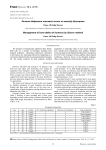Оригинальные статьи. Рубрика в журнале - Гений ортопедии
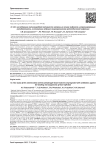
Статья научная
Цель. Оценить результаты сравнительного анализа антимикробной in vitro активности полимерных гидрогелей и ПММА, импрегнированных антибиотиками, в отношении тест-культур ведущих возбудителей ортопедической инфекции. Материалы и методы. Проведен сравнительный анализ антимикробной активности полимерного гидрогеля и ПММА, импрегнированных антибиотиками. Оценена бактерицидная эффективность и пролонгированность действия следующих пар «микроб-антибиотик»: MSSA - гентамицин, MSSE - цефазолин, MRSA и MRSE - ванкомицин, A. baumannii - тобрамицин. Длительность исследования - 7 суток. Статистическое сравнение групп проведено при помощи критериев Манна-Уитни, Уилкоксона, для описания данных использовали медиану и 95 % ДИ. Результаты. Полученные показатели зоны ингибирования роста микроорганизмов вокруг полимерного гидрогеля в несколько раз превосходили результаты ПММА (p
Бесплатно
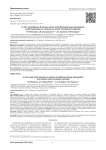
Статья научная
Цель. Изучить динамику и длительность элюции антибактериальных препаратов из образцов на основе полимерного гидрогеля и ПММА. Материалы и методы. Сравниваемые образцы, импрегнированные ванкомицином, рифампицином и цефазолином в различных концентрациях, помещали в фосфатно-солевой буфер, инкубировали при 37 °C. На 1, 3, 7, 14, 21 и 28 сутки проводили полную замену среды. Концентрацию препаратов в растворе и их профили высвобождения определяли спектрофотометрическим методом. Для статистического описания данных 5 параллельных исследований использовали медиану и 95 % ДИ. Результаты. На протяжении всего периода исследования концентрации всех протестированных антибиотиков, элюированных из полимерного гидрогеля, превышали концентрации, высвобожденные из ПММА, в среднем в 7 раз на 1-е сутки, в 15 раз - на 2-е и 3-и сутки, в 6,6 раза - на 7-е сутки, в 3 раза и более - в последующие дни наблюдения. Заметно отличалась и скорость релиза антибиотиков из объема гидрогелей. Обсуждение. Для всех гидрогелевых образцов релиз препаратов составил более 70 % от его общего количества, в отличие от ПММА, элюция которого не превышала 10 %. Несмотря на то, что, как и в случае костного цемента, наблюдался бёрст-релиз, и до 80 % антибиотика высвободилось в первые 5 суток наблюдений, концентрация элюированного препарата из гидрогелей была кратно выше и превышала МПК в течение всего периода наблюдения. Высвобождение противомикробного агента из гидрогелей обусловлено диффузией частиц из вcего объема матрицы, что является важным преимуществом по сравнению с ПММА, потенциал которого ограничен поверхностным истощением. Заключение. На данном этапе нами показана возможность создания потенциальных депо-систем на основе ненасыщенных производных ПВС с контролируемым релизом антибиотиков, которые превосходят по своим характеристикам ПММА.
Бесплатно
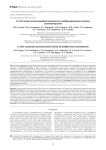
In vitro оценка антимикробной активности модифицированных костных ксеноматериалов
Статья научная
Цель. Оценка антимикробных свойств оригинальных костных имплантационных ксеноматериалов, импрегнированных по разным технологиям ванкомицином. Материалы и методы. Костный ксеноматрикс модифицировали по двум технологиям: адсорбция ванкомицина на поверхности материала и абсорбция ванкомицина в объеме материала с использованием промежуточного носителя. При импрегнации антибиотика использовали метод сверхкритической флюидной экстракции диоксидом углерода. Изучена кинетика высвобождения антибиотика из модифицированного ксеноматериала. В исследовании in vitro изучена его антимикробная активность по отношению S. aureus. Результаты. Обнаружено, что выход ванкомицина из материала, выполненного по технологии адсорбции, после 24 часов инкубации составил более 98 % от исходного содержания в матриксе. Остаточное содержание антибиотика в среднем составляло 1,75 %. Использование промежуточного носителя (L/D изомер полилактида) позволяет получить материал с дозированным пролонгированным выходом ванкомицина...
Бесплатно
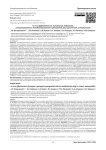
Статья научная
Введение. Полиметилметакрилат (ПММА) является распространенной депо-системой при лечении хронического остеомиелита. Однако множество существующих недостатков не позволяет считать его идеальной.Цель. В условиях in vivo изучить эффективность купирования хронического остеомиелита большеберцовой кости на модели кроликов полимерным гидрогелем, содержащим антибиотик, и сравнить с ПММА.Материалы и методы. Исследование выполнено на голени 25 половозрелых кроликов породы Шиншилла. Была создана модель хронического остеомиелита большеберцовой кости. Инфекционным агентом выбран метициллинчувствительный штамм Staphylococcus aureus (MSSA), высокоактивный в отношении цефазолина. Через 21 день после клинико-лабораторного, рентгенологического имикробиологического подтверждения диагноза приступали к хирургической санации, методика для всех животных была одинаковой. Опытной группе (n = 11) имплантировали полимерный гидрогель, сравнительной (n = 11) - ПММА, контрольной (n = 3) - имплантация не производилась. В послеоперационном периоде проводили мониторинг локального статуса, веса и температуры тела животных, микробиологическое и рентгенологическое исследование. Животных выводили поэтапно. Биоптаты направляли на бактериологическое и гистоморфометрическое исследование. Статистическое сравнение групп выполнено при помощи критериев Манна - Уитни, Краскелла - Уоллиса и Тьюки, для контрольной группы использовали описательную статистику.Результаты. В опытной группе во всех случаях послеоперационные раны зажили своевременно, уровни WBC и СРБ значимо (p = 0,040) снизились с 14 и 21 суток соответственно. Микробиологически роста микрофлоры из отделяемого раны и биоптатов не выявлено, рентгенологически прогрессирование хронического остеомиелита не наблюдалось, гистоморфометрически отмечено достоверное (p = 0,002) эффективное купирование воспалительного процесса. В случае сравнительной группы с 7-х послеоперационных суток потребовалась системная антибиотикотерапия. Уровни маркеров воспаления снижались менее эффективно, чем в опытной группе. MSSA верифицировался из отделяемого раны и биоптатов почти на каждом контрольном сроке. Рентгенологически и гистоморфометрически (p = 0,001) в среднем наблюдалась картина обострения остеомиелита. В контрольной группе системная терапия не дала положительной динамики.Обсуждение. Сравнительный анализ показал, что гидрогель в отличие от ПММА достоверно купирует хронический остеомиелит без дополнительной вспомогательной системной антибиотикотерапии и не вызывает материал-ассоциированную резорбцию костной ткани. При этом клинико-лабораторная картина полностью соответствует данным микробиологии, рентгенологии и гистоморфометрии.Заключение. Гидрогель, импрегнированный антибиотиком, достоверно и эффективно купирует хронический остеомиелит по сравнению с ПММА.
Бесплатно
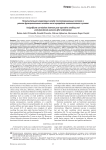
Статья научная
Introduction Swelling is a common complication following a foot and ankle surgery, and is one of the most prevalent complaints that patients present at the clinics. While it affects patients’ satisfaction, the relevance between the swelling and clinical outcome remains unclear. Material and Methods This study assessed volume of foot and ankle swelling in 112 patients with history of ankle fusion, the patients’ Foot Function Index (FFI) score, and patients’ satisfaction. The relationships between swelling volume and early outcomes were analysed with Pearson’s correlation coefficient and a scatter plot. Results The mean of swelling volume increase was 120.0 ± 96.2 ml (range 5 ~ 400 ml); pre-operative FFI score mean was 73.7 ± 4.8 % (range 68 % ~ 81 %), 3 months post-operative FFI score mean was 32.8 ± 5.0 % (range 22 % ~ 56 %) and satisfaction scale’s median was 1 (satisfied). In the correlation analysis, while the meaningful Pearson’s correlation coefficient was found with satisfaction scale, swelling volume showed a weak correlation of Pearson’s correlation test with FFI scores (R value = 0.190; p value = 0.045). Conclusions This study revealed that the swelling of the foot and ankle following ankle fusion surgery are not associated with functional clinical outcome. However, because it affects the patients’ satisfaction, we emphasize the need to identify the problem and management of the swelling, while assuring them that the swelling does not correlate with the early functional outcome.
Бесплатно
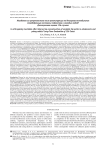
Статья научная
Introduction Whereas hip joint destroying trauma and diseases are difficult situations, the problem is more complex when it is complicated by hip instability. This could be a sequel of several hip affections such as trauma, septic or tuberculous arthritis, neglected developmental dysplasia of the hip, postoperative conditions, and neurologic pathologies (cerebral palsy, myelomeningocele, poliomyelitis). Purpose The purpose of this study is to evaluate long-term radiographic and clinical outcomes of the Ilizarov hip reconstruction for the treatment of painful and unstable hips in adolescents and young adults. Materials and methods The study included 136 patients with an average age of 18.3 years (range, 6 to 34 years); 75 patients were males (55.1%) and 61 females (44.9%). The primary causes of the hip instability were untreated or unsuccessfully treated cases of septic arthritis (40 cases; 29.4 %), congenital hip dislocation (28 cases; 20.6 %), paralytic hip dislocation (36 cases; 26.5 %), proximal femoral focal deficiency (14 cases; 10.3 %), neglected fracture of the femoral neck (10 cases; 7.4 %), osteoarthritis (6 cases; 4.4 %), and tuberculous hip arthritis (2 cases; 1.5 %). The intervention consisted in the performance of two osteotomies (proximal and distal) of the femur with pelviс support and placement of the Ilizarov apparatus of a specific assembly. Results The external fixation period ranged from 4 to 12 months (6.5 months on average). Patients were followed up for an average of 17.4 years (range, 5 to 27 years). Multiple clinical parameters at final follow-ups showed significant improvement, including pain relief, pain-free walking distance, lameness, hip flexion and abduction, hip contracture, and lumbar lordosis. Functionally, the mean Harris Hip Score improved with a statistically significant difference from 48 points (range, 35-65) before surgery to 83 points (range 70-90) after surgery. The pain disappeared in all patients, with the exception of six cases of pain in the early postoperative period. In all cases, supportive walking aids were no longer necessary, with the exception of two cases of persistent pain by physical activities. Walking ability and painless walking distance improved in all patients from an average of 35 m (range, 10 to 50 m) before surgery to 1,150 m (range, 1,000 to 1,500 m) after surgery, showing significant difference. Conclusion Ilizarov pelvic support osteotomy provided a multi-purpose solution to the complex challenging problem of hip instability in adolescents and young adults with variable primary etiologies. The improvements in the hip motion, mechanical axis, and correction of limb-length discrepancy lead to good functional outcomes over a long-term follow-up. This treatment modality might avoid or postpone the need for total hip arthroplasty for several years.
Бесплатно
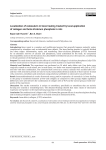
Статья научная
Introduction Bone repair is a complex and multifaceted process that generally happens naturally unless complicated by situations such as substantial bone defects. The bone healing process is typically divided into three stages: inflammation, repair, and remodeling. Beta-tricalcium phosphate (β-TCP) renowned for its abundant reserves of calcium and phosphorus, easily assimilated by the body. Its exceptional biocompatibility assists in the formation of an absorbable interlinked structure at the injury site, contributing to the advancement of the healing process.Purpose This study aimed to estimate the effects of a scaffold of collagen/β-tricalcium phosphate (Coll/βTCP) on bone construction to evaluate its latent usage as a bone auxiliary to repair bone defects.Material and Methods The experiment was performed on 20 adult male albino rats. Four holes were surgically created on each animal, two in each femur; two holes were treated separately with Coll or β-TCP, one hole with their combination. The untreated hole served as a control. Animals were scarified after twoand four-week treatment periods (10 rats for each). Immunohistochemical analysis of bone marrow stromal cells, osteocytes, osteoblasts and osteoclasts using polyclonal antibodies to osteocalcin was performed.Result Immunohistochemical results discovered strong positive expression of osteocalcin in bone healing in the group of combined treatment (β-TCP and collagen) as compared to other groups. Highly significant differences were seen between the combination of collagen with β-TCP and the control group at both timepoints of the experiment.Discussion The marker osteocalcin is unique to osteoblasts, specifically to osteoblasts that are actively forming new osteoid or remodeling bone. The obtained findings showed that mean values of osteocalcin expression were greater in the experimental groups than in the control group.Conclusion The combination of collagen with β-TCP showed the greatest efficacy in accelerating bone healing and increasing osteogenic capacity due to increased osteocalcin immunoreactivity.
Бесплатно
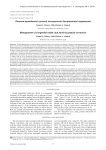
Management of congenital radial club hand by gradual correction
Статья научная
Introduction Severe congenital radial club hand is aesthetically unacceptable. This paper represents our experience in treating early and late diagnosed cases using gradual distraction by Ilizarov external fixator. Methods We treated 34 cases of congenital radial club hand with an age ranged from 1 to 15 years. There were 20 girls and eight bilateral cases. Three had been treated on both sides. So, we have treated 37 limbs. Nine cases had been operated before. Centralization alone was done in 12 cases and followed by lengthening in eight cases. Ulnar lengthening and gradual correction of wrist deformities were done for the rest of cases. The patients were followed clinically and radiographically with the following parameters: hand forearm angle, range of motion, daily functional activities, extent of lengthening achieved, and cosmetic improvement. Results The follow up ranged from 1 to 10 years. The magnitude of lengthening achieved ranged from 5 to 11 cm. The average healing index was 52.02 days/cm with cosmetic appearance satisfaction in all cases. Complications included; pin tract infection in 24 cases, flexion contractures of the elbow and fingers in 26 cases [which mostly disappeared during follow up], and spontaneous ulnocarpal fusion in 2 cases. Two cases suffered fracture in the regenerate zone. Conclusions The use of the Ilizarov method with gradual distraction of bone and soft tissues in treatment of radial club hand was effective in forearm lengthening with functional and cosmetic improvement.
Бесплатно
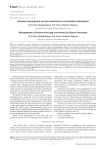
Management of forearm bone gap non-unions by Ilizarov technique
Статья научная
Purpose Proper treatment of forearm bone gap non-union should achieve both biological stimulation of the bone and elastic mechanical stability. The use of Ilizarov technique enhances the healing of a non-union providing osteogenic, osteoconductive and an optimal stability with the Ilizarov fixation. We retrospectively reviewed 26 patients affected by forearm bone non-union and treated with the Ilizarov fixation. Materials and Methods Twenty six patients were treated for gap non-unions of forearm bones with the Ilizarov compression distraction device from 2000 to 2015 in BARI-ILIZAROV ORTHOPAEDIC CENTRE. Results All the difficult non-unions healed in a mean of 7 months, ranging from 5 to 12 months. At the latest follow- up, forearm functions were satisfactory. Conclusion The Ilizarov compression distraction device is a fantastic tool in promoting the healing of forearm non-unions, even if the bones are very atrophic.
Бесплатно
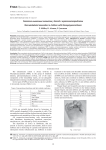
Musculoskeletal anomalies in children with mucopolysaccaridoses
Статья научная
Introduction The accumulation of glycosaminoglycan (GAGs) in the tissues in Mucopolysaccharidoses (MPS) can lead to skeletal anomalies (DYSOSTOSIS MULTIPLEX) and to soft tissue impairments (neural or medullar compression, joint stiffness, tenosynovitis). Here is a review of orthopedic issues frequently encountered in patients with MPS. Material and methods Surgery may be justified at different age and according to the type of MPS. Different surgical approaches and their indications are exposed in the article. Results The article exposes indications and techniques for orthopedic issues in MPS children: cervical stenosis, cervical instability, kyphosis, hip dysplasia and hip dislocation, genu valgum. Conclusion Various musculoskeletal anomalies can be found in patients with mucopolysaccharidoses. Neurological impairments are frequently seen due to cervical stenosis or instability and should be early detected with regular MRI of the cervical spine. Well-codified management should lead to favorable functional results and maintain functional and walking abilities.
Бесплатно
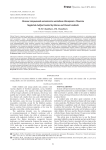
Neglected сlubfoot treated by Ilizarov and Ponseti methods
Статья научная
The Ponseti method has revolutionized clubfoot treatment. Though completely neglected clubfeet are now rare, partially or incompletely and improperly treated feet are not uncommon. Relapses after successful correction may occur due to non-compliance with bracing. In scarred soft tissues due to previous surgery, soft tissue distraction using external fixation helps achieve correction. The Ilizarov fixator permits us to follow the Ponseti protocol, using correction methods that may either be constrained or unconstrained by hinges. Applying force vectors perpendicular to the moment arm allows us to correct the equinus without damaging the ankle joint. All of the above is possible when the talus is round. Full correction of the deformity is possible. However, long-term follow-up of these patients has revealed stiffness of the ankle setting and frequently with tibio-talar osteophytes anteriorly. They are probably a reaction to excessive pressure developed in the joint due to the tight soft tissues. Hence the author has now added a mild shortening of the tibia and fibula to reduce soft tissue tension, rather than resorting to further soft tissue releases through scarred tissues. This allows faster correction with the Ponseti-Ilizarov protocol and allows good ankle range of motion to persist.
Бесплатно
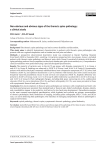
Non-obvious and obvious signs of the thoracic spine pathology: a clinical study
Статья научная
Background The thoracic spine pathology can lead to severe disability and discomfort.This study aims to identify determinant characteristics in patients with thoracic spine pathologies who present with non-regional complaints such as lumbar/cervical pain and others.Methods A prospective observational descriptive study was conducted at Basrah Teaching Hospital from March 2020 to December 2021, enrolling 114 patients categorized into two groups. Group A included patients with thoracic spine pathology and thoracic pain, while Group B consisted of patients with thoracic spine pathology and non-local symptoms (such as lower lumbar pain, pain in extremities, etc.). Comprehensive clinical evaluations were performed using a specially designed questionnaire.Results The majority of patients were in the 60-79 age group, with females comprising 55 % in Group A and 60 % in Group B. Smoking was observed in 28.98 % of Group A and 26.66 % of Group B. Symptomatic patients with solitary back pain commonly exhibited dorsal root compression symptoms (49.27 %), lower limb weakness (18.84 %), and sphincter dysfunction (7.24 %). Patients with thoracic plus lower and/or neck pain frequently reported paraesthesia (42.22 %) and cervical root symptoms (48.38 %). Kyphotic deformity was present in 20.28 % of Group A and 11.11 % of Group B, while tenderness was observed in 23.18 % of Group A and 13.33 % of Group B. Plain radiograph changes, including disk space narrowing (44.44 %), subchondral sclerosis (29.63 %), curve alterations (29.63 %), and facet arthropathy (25.9 %), were more prevalent in those with symptomatic thoracic back pain (Group A).Conclusion Non-local symptoms in thoracic spine pathologies are common, with complicated and multi-site low back pain being more prevalent than isolated back or thoracic pain. Elderly individuals, females, obesity, and comorbidities appear to be predictive risk factors for low back pain development. Paraesthesia emerges as the most common neurological manifestation, while kyphosis and scoliosis are primary presentations of thoracic pathologies. Multi-modalities of imaging, including plain radiographs, MRI, CT scan, and DEXA scan, can aid in detecting back pathologies. The mainstay of managing symptomatic thoracic pathologies is surgical intervention.
Бесплатно
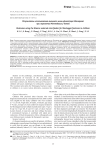
Outcomes using the Ilizarov external mini-fixator for Monteggia fractures in children
Статья научная
Objective To evaluate the use of Ilizarov external mini-fixation in the treatment of Monteggia fractures (dislocation of the radial head with an associated fracture of the proximal ulna) in children. Methods Children with proximal ulnar fracture were included and underwent fracture reduction surgery with Ilizarov external mini-fixators, followed by immobilization of the supinated forearm with plaster. The reduction was evaluated intra-operatively using arthrography. Mackay criteria were used to evaluate clinical outcomes at follow-up. Results A total of 15 children were included in the study. Mackay efficacy was 100 %, indicating excellent outcomes using the Ilizarov external mini-fixator. Conclusion Use of the Ilizarov external mini-fixator is particularly suitable in the treatment of children with comminuted and compression fractures of proximal ulna. It is easy to operate, low invasive and is worthy of promotion.
Бесплатно
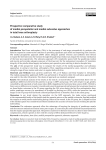
Статья научная
Introduction Total knee arthroplasty (TKA) is the treatment of end-stage osteoarthritis in patients who failed to respond to conservative treatment in providing significant pain relief and improving joint function. The medial parapatellar approach (MPP) allows adequate patellar eversion and sufficient knee flexion to expose the knee joint, but the incision through the quadriceps tendon may impair the extensor mechanism of the knee post-operatively. The subvastus approach (SV) completely spares both the quadriceps tendon and muscle and provides adequate exposure of the knee joint for the replacement procedure, SV maintains integrity of the patellar blood supply and reduces post-operative pain resulting in shorter hospital stay.The aim of this prospective study was to compare the results of the medial parapatellar and subvastus approaches in primary total knee arthroplasty (TKA) regarding postoperative pain, recovery of muscle strength, range of knee motion and return to regular daily activities.Materials and Methods Sixty patients underwent TKA at El-Hadara university hospital in Alexandria. The medial parapatellar apphroach (MPP) was performed in 30 patients while the subvastus approach (SV) was used for the other 30 patients. The choice of approach was randomly assigned.Results The statistical analysis of the results at the end of a 6-month follow-up showed that there were no significant differences between the patients in group 1 (MPP) and group 2 (SV) with respect to age, gender, comorbidity, side operated or body mass index (BMI). Regarding the functional knee scores (IKDC, WOMAC), there were no differences at 4 weeks, 3 months and 6 months postoperatively between the two groups. However, we found better outcomes in the SV group regarding the VAS score during the first five postoperative days, earlier quadriceps recovery by assessment of Straight Leg Raising test (SLR), while the operative time was longer in the SV group with less blood collected postoperatively in hemovac drain in the same group.Discussion In our study during the operation via the MPP approach, the index suture positioned at the superomedial border of the patella and the opposite suture on the medial retinacular flap had enabled the surgeon to avoid patellar maltracking during closure of the wound. In the SV group, the L-shaped incision of the medial capsule was considered an efficient landmark for accurate soft tissue closure avoiding the patellar maltracking.Conclusion The subvastus approach offers the advantage of keeping the integrity of quadriceps muscle and the extensor mechanism remains intact post-surgery. It causes less pain and less blood loss postoperatively than the regular parapatellar approach. The patient could recover the knee function in a shorter time with fewer complications, which is greatly in line with the concept of ERAS (Enhanced Recovery After Surgery).
Бесплатно
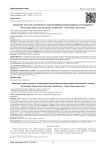
Pyomyositis: case series of 14 patients to study the significance of early diagnosis and management
Статья научная
Introduction Pyomyositis denotes primary pyogenic infection of skeletal muscle. It is predominantly a disease of tropical countries. It usually involves the largest muscle groups around the pelvic girdle and lower extremities. Primary reasons for delay in diagnosis are its low incidence and vague presentation [7]. This delay can result in complications such as extension into and destruction of an adjacent joint, sepsis and, even death. Our study is aimed to highlight the extent and sequence of treatment protocol required for good management of these patients. Methods We retrospectively analyzed our experience with a series of 14 pediatric patients with primary pyomyositis who were treated and followed up. There were five girls and nine boys. All 14 patients underwent plain radiographs, USG and MRI of the affected area followed by surgical drainage and a course of antibiotics. Patients were followed up with weekly CRP. Results Six out of 14 (42.9 %) patients had a history of mild trauma. Ileopsoas muscle was involved in 4 patients, 3 cases in which the gluteals or quadriceps were involved, 2 cases with obturator muscle involvement and 2 cases in which adductors were the infection site. All 14 patients were treated surgically. Conclusion Our study shows that early diagnosis, complete drainage of the purulent material and the use of appropriate antibiotic therapy are the key determinants of successful treatment that lead to complete resolution in the majority of cases.
Бесплатно
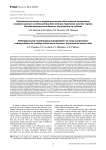
Статья научная
Optimizing the conditions for cranial bone fracture healing remains to be a relevant field of the current traumatology and orthopaedics. Purpose. To study the impact of compression on reparative osteogenesis when engrafting the resected flaps of calvarial bones. Materials and methods. Two groups of experiments performed in 20 adult mongrel dogs complying with all the requirements of the European Convention for the Protection of Vertebrate Animals used for Experimental and other Scientific Purposes. Dogs from Group 1 (n=10) underwent resection of the two sites of calvarial bones (the caudal flap preserved connections with surrounding soft tissues, the cranial flap - not preserved) of rectangular shape and 1.9×1.5 cm by size, they were laid into their former place and fixation performed with compression using thin wires with stoppers to the medial defect margin by transosseous osteosynthesis method. Compression produced by tightening fixing wires with the force of 40 kg. In Group 2 (n=10) bone flaps were laid into the defect without fixation. The investigations (clinical, radiological and histological) performed 7, 14, 21, 28 and 60 days after surgery. Results. Compression produced at the junction of the margins of free bone fragments and calvarial flat bone defect revealed to contribute to bone tissue formation in earlier periods of time. Conclusion. The results obtained in the present study formed the basis for using the technique of transosseous compression osteosynthesis in treatment of patients with cranial bone fractures in clinical departments of the Center.
Бесплатно
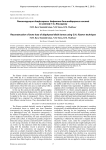
Reconstruction of bone loss of diaphyseal tibial bones using G.A. Ilizarov technique
Статья научная
The treatment of segmental defects in the diaphysis of long bones is one of the most difficult problems that a surgeon faces in his practice. Methods that are used to cover bone defects include bone autotransplantation [1], posterolateral bone transplantation [2], allotransplantation [3], and tibialization [4]. With the application of all the above traditional methods of treating bone defects, numerous surgical interventions are sometimes required. The period of treatment is long, the load on the limb may not be possible, and the functional results are often unsatisfactory. Recent studies have demonstrated that the method used GA. Ilizarov is more popular than the use of vascularized bone grafts, especially with large bone defects [5, 14].
Бесплатно
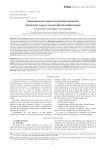
Reconstructive surgery in recurrent deformity (clubfoot relapse)
Статья научная
Introduction Recurrent clubfoot deformity may be due to either an imperfect initial correction, or a natural history of a severe disease. In the later, idiopathic clubfoot is uncommon. In the review we describe reconstructive surgery in recurrent deformity of idiopathic clubfoot. Material and methods Surgery may be justified at different age and according to the type of deformity. Different surgical approaches and their indications are exposed in the article. Results After Ponseti’s method application additional surgeries may be considered in recurrent clubfoot deformity which may represent 10 to 20 % of cases: second Achilles tenotomy, postero-lateral relapse, complete antero-medial and postero-lateral relapse, transfer of the anterior tibial tendon, correction of sequelae: metatarsus varus, residual equinus, residual rotation of the calcaneopedal unit. Conclusion Idiopathic equine varus clubfoot is a frequent condition. Well-codified management should lead to extremely favorable functional results. Unfortunately, some cases lead to a recurrence of the deformity. Surgical procedures are sometimes required. The goal is to avoid as much as possible arthrodesis and secondary degenerative arthritis.
Бесплатно
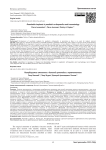
Resorbable implants in paediatric orthopaedics and traumatology
Статья научная
Background Development of resorbable implants for paediatric orthopaedics is promising as there is no need for implant removal.The aim of this paper is to present our experience in resorbable implants in paediatric traumatology, and to make an overview of the recent literature.Material and methods In our department of paediatric traumatology and orthopaedics, we have operated 7 children with fractures of long bones with resorbable screws (ActivaScrew™). The inclusion criteria were intra-articular and juxta-articular fractures in children with an indication for screw fixation. To prepare the review, we searched for information sources at the scientific platforms such as PubMed, Scopus, ResearchGate, RSCI, as well as other published products (Elsevier, Springer).Results The cohort is represented by 7 patients, 4 girls and 3 boys, aged from 5 to 14 years old. The 7 fractures were 3 at the elbow and 4 at the ankle joint. In the immediate postoperative period, no patient presented with abnormal swelling, redness, or tissue reaction. Pain disappeared at day 7 in all cases. Weight-bearing and return to sport activities were allowed in normal delay. Radiological bone union was obtained between 3 and 6 weeks. Range of motion in adjacent joints was comparable to the opposite non-fractured side at 3 months. There were no cases of complications, no infection, and no need for a reoperation.Discussion The use of resorbable implants, either co-polymers or magnesium, solves the problem: removal of implants is not anymore necessary. Resorbable implants are becoming safer as they have good solidity allowing bone union of fractures and osteotomies before their eliminating.Conclusion Main indications of resorbable implants in pediatrics remain fractures and osteotomies fixed with screws. The development of plates and intramedullary nails will enlarge the indications. Level of evidence: IV.
Бесплатно

